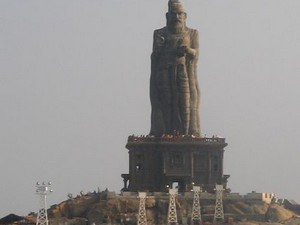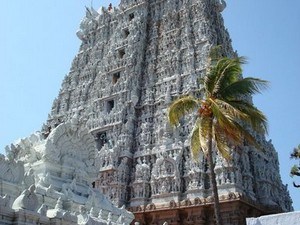Suchindram, Kanyakumari - Timings, Festivals, History, Darshan, Pooja Timings
Photo Credit: Flickr
 #4 of 35 Places to Visit in Kanyakumari
#4 of 35 Places to Visit in Kanyakumari
 Distance (From Kanyakumari): 12 Kms
Distance (From Kanyakumari): 12 Kms
 Trip Duration (Including Travel): 1-2 Hours
Trip Duration (Including Travel): 1-2 Hours
 Place Location: On Trivandrum - Kanyakumari Road
Place Location: On Trivandrum - Kanyakumari Road
 Transportation Options: Cab / Auto
Transportation Options: Cab / Auto
 Travel Tips: None
Travel Tips: None
About Suchindram Temple
At a distance of 7 Km from Nagercoil, and 12 Km from Kanyakumari, Suchindram is a holy place located on the bank of the river Pazhayar in Tamilnadu. Situated on Trivandrum - Kanyakumari road, Suchindram is famous for the Thanumalayan Temple dedicated to Lord Shiva. Also called Sthanumalayan Temple, it is one of the famous places to visit as part of the Kanyakumari pilgrimage packages. The Thanumalayan Temple holds significance for both Shaivaite and Vaishnavite sects of Hinduism, as the term Stanumalaya represents the Trimurtis; 'Stanu' refers to Shiva, 'Mal' to Vishnu, and 'Ayan' to Brahma. It is recognized as one of the Abhimana Kshetrams in Vaishnavite beliefs and is also considered one of the 108 Shiva Temples esteemed by the Kerala Hindu community, despite its current location in Tamil Nadu following the incorporation of Kanyakumari District from Travancore.
History of Suchindram Temple
The existing masonry structure was constructed in the 9th century during the Chola dynasty and underwent renovations by the Madurai Nayak kings in the 17th century CE. Numerous inscriptions from the early and medieval Chola periods, as well as those from other regional rulers such as the Pandyas and Cheras, can be found in the area. The Travancore Maharajas, who oversaw the temple until Kanyakumari's incorporation into Tamil Nadu, contributed significantly to its maintenance through various endowments. A significant development during this time was the introduction of a lottery system in 1875 by Ayilyam Thirunal Rama Varma Maharajah, aimed at generating funds for the temple's restoration. The temple is currently managed and maintained by the Dharmapuram Aadhenam.
Mythology of Suchindram Temple
The place where the temple is located was initially named Gnaaranya. According to legend, Indra, the King of the Gods, became enamored with Ahalya, the spouse of sage Gautama, and, through deceit, violated her. Upon discovering this, the sage transformed his wife into stone and cursed Indra, decreeing that a thousand female genitalia would emerge across his body. Overcome with shame, Indra undertook severe penance at this site, and ultimately, through the grace of Shiva and others, he restored his original form. In gratitude, Indra constructed a shrine for the divine trinity at this location, which subsequently became known as Suchi Indram - the site of Indra's purification. To this day, the midnight pooja at this temple is not conducted, although all necessary items are prepared. It is believed that Indra himself visits the temple at night to perform the pooja.
As per another legend, Lord Shiva, Lord Vishnu, and Lord Brahma sought to test the purity of Anusuya, the wife of sage Atri. Disguised as impoverished brahmins, they arrived at the sage's hermitage. As Anusuya was about to serve them a meal, the trinity imposed a condition that they would accept her hospitality only if she appeared before them unclothed. Utilizing her power of chastity, she transformed the three gods into small children, breast-fed them, and lulled them to sleep. Alarmed, the consorts of the trinity implored Anusuya to restore them to their true forms. She complied, and in gratitude, the trinity blessed Anusuya and Atri with a child, Lord Dattatreya, who embodied the essence of all three deities. The three manifested as three Lingas, and the site where the couple worshipped the trinity is believed to be the Thanumalayan temple.
Architecture of Suchindram Temple
The temple complex showcases a distinctive combination of Kerala and Tamil architectural styles, spanning approximately two acres and featuring two gateway towers, known as gopurams. The eastern tower stands as the tallest, with 7 stories and a height of 134 feet. A notable feature of this temple is the four musical pillars, intricately carved from a single stone, located in the alankara mandapam area. These pillars produce a range of musical notes when struck with a thumb. Additionally, the temple includes a dancing hall adorned with around 1,035 exquisitely carved pillars.
Within the temple, there are numerous shrines, with the most significant being those dedicated to Sthanumalayan and Hanuman. The main deity is Sthanu (Lord Shiva), whose idol, along with those of Mal (Lord Vishnu) and Aya (Lord Brahma), resides in the sanctum sanctorum. Separate shrines are also dedicated to Lord Rama and Sita, Ganesha, the Navagrahas, Kailasanathar, the Pancha Pandavas, Guru Dakshinamurthy, Murugan, Garuda, Subramania Swamy, and many others.
Another remarkable feature is the 22-foot statue of Anjaneya (Hanuman), carved from a single block of granite. This statue, one of the largest in India, was concealed within the temple due to fears of attacks from Tipu Sultan. It was rediscovered in 1930 and restored to its former glory. Another impressive element is the carving of Vinayaki (Female Vinayaka) within the temple. The majestic image of Nandi, the vehicle of Lord Shiva, is also striking, measuring 13 feet in height, 21 feet in length, and 10 feet in width.
Festivals of Suchindram Temple
The Margazhi Thiruvadhirai Car festival is the most celebrated event at the Suchindram Thanumalayan Temple, lasting for ten days. This festival occurs during December and January and draws large crowds. Unique worship rituals are observed, and the festival features processions where the deities Sthanumalayan, Aram valartha Nayagi, and Vinayagar are paraded through the streets in a temple chariot. Additionally, the temple hosts other significant festivals, including the Avani Festival in August, the Chithirai Festival in April, and the Masi Festival in March.
Suchindram Temple Dress Code & Other Restrictions
When planning a visit to the Thanumalayan Temple in Suchindram, it is recommended to adhere to modest clothing that covers your upper arms and legs as a sign of respect. Men are encouraged to wear a dhoti or pajama paired with an upper garment, as well as formal trousers and shirts. Women may opt for a saree, half saree, or churidhars. Men need to remove their shirt before entering the sanctum sanctorum of the temple. It is advisable to refrain from wearing contemporary attire such as mini-skirts, jeans, shorts, and sleeveless tops while on the temple grounds. Dhotis for men are available for rent just for Rs. 20 in the temple premises.
Non-Hindus are welcome to explore the temple complex and appreciate its architectural beauty; however, access to the sanctum sanctorum may be restricted.
Suchindram Temple Timings
Monday: 4:30 AM - 11:30 AM & 5 PM - 8:30 PM
Tuesday: 4:30 AM - 11:30 AM & 5 PM - 8:30 PM
Wednesday: 4:30 AM - 11:30 AM & 5 PM - 8:30 PM
Thursday: 4:30 AM - 11:30 AM & 5 PM - 8:30 PM
Friday: 4:30 AM - 11:30 AM & 5 PM - 8:30 PM
Saturday: 4:30 AM - 11:30 AM & 5 PM - 8:30 PM
Sunday: 4:30 AM - 11:30 AM & 5 PM - 8:30 PM
Suchindram Temple Entry Fee
General Entry is Free
Special Darshan available for Rs. 250
Best Time to Visit Suchindram Temple
The best time to visit Suchindram Temple is from October to March, while the peak season is from November to February. The Margazhi Thiruvadhirai Car festival occurs during December/January, and Maha Shivaratri in February/March offers a remarkable opportunity to immerse oneself in the temple's lively ambiance, drawing thousands of devotees. It is advisable to avoid visiting the temple in the peak summer months from April to June, as temperatures can rise significantly, complicating outdoor activities.
How to Reach Suchindram Temple
Trivandrum Airport serves as the closest airport, located approximately 97 kilometers from Kanyakumari. About 7 km & 12 km from Suchindram, Nagercoil Junction, and Kanyakumari Railway Station are the nearest railheads that are well-connected by rail to major cities such as Chennai, Bangalore, Mumbai, Trichy, Madurai, Hyderabad, Delhi, Trivandrum, Kochi, Kolkata, and Jammu. Additionally, there is excellent bus service linking Kanyakumari to Trivandrum, Madurai, Trichy, Tirunelveli, Pondicherry, Kochi, Chennai, and Bangalore. The Suchindram Temple can be accessed by taking a bus or by hiring an auto-rickshaw or cab from these places.


















